In this report, Syrians for Truth and Justice (STJ) unveils the details of three Turkish airstrikes in northeast Syria. The attacks targeted a printing press, a cotton ginning facility, and a straw plant, inflicting massive damage on these facilities, which were the sole source of income for dozens of the region’s households. Additionally, the report narrates the stories of two young women who worked in these places to support their families financially.
The report builds on six interviews conducted by STJ’s field researchers with relatives of the victims, survivors, witnesses, and business owners. In addition to the statements obtained during these interviews, the report analyses a wide array of visuals obtained exclusively by STJ and Syrian and Turkish open-source information on the airstrikes.
On 25 December 2023, several locations in northeast Syria, controlled by the Autonomous Administration, were targets of extensive and large-scale airstrikes the Turkish military carried out using both drones and fighter jets. On 26 December 2023, the Turkish Intelligence Service announced the toll of the attacks, revealing that they destroyed nearly 50 facilities in various cities across the region, including Qamishli/Qamishlo, Amuda, and Ayn al-Arab/Kobanî. The Turkish authorities allege these facilities were used by the Kurdistan Workers’ Party (PKK)—which Türkiye designates as a terrorist organization, and the Syrian Democratic Forces (SDF), particularly the People’s Protection Units (YPG)—which Türkiye treats as the PPK’s branch in Syria.
However, information and evidence complied by STJ through field visits to several targeted facilities and interviews conducted with workers there corroborate that these facilities are civilian objectives, provide services to the local community, and were not used for military purposes. Most importantly, the collected information proves Türkiye’s non-commitment to avoiding causing harm to civilians and civilian objectives.
Furthermore, STJ identified and geolocated eight out of 11 facilities that appeared in drone footage of the December 25 attacks, published by the Turkish media outlet TRT HABER. One of the attacked facilities is a medical oxygen plant in the backyard of the Kidney Dialysis Center in the Alaya neighbourhood in Qamishli/Qamishlo city. The airstrike rendered the center out of service.
Notably, the 25 December airstrikes—which killed at least nine civilians and injured 18 others—were part of a series of attacks on vital infrastructure in northeast Syria that escalated in November 2023 and January 2024 while the world’s attention focused on the conflict in Gaza.
In response to this large-scale and extended aerial military campaign in northeast Syria, 158 Syrian civil society organizations condemned the Turkish airstrikes on civilian facilities. They called on the United Nations Security Council to protect civilians and their livelihoods, as well as to cease the targeting of vital infrastructure necessary for the survival of the population. For its part, Human Rights Watch said the Turkish strikes were wreaking havoc on the region, damaging civilian infrastructure, leaving millions without access to essential services.
Airstrike on the Simav Printing Press
On Christmas morning, at around 10:30 a.m., Turkish warplanes hit the facilities of the Simav Printing Press in Qamishli/Qamishlo city. The printing press was a public facility; it provided services to the local community while specializing in printing books, magazines, and newspapers. The strike killed seven of the facility’s workers and clients and injured several others. It also inflicted massive damage on its building and equipment, rendering it out of service.
The victims are Berivan Zubair Muhammad, an employee at the printing press; Farhan Khalaf, director of the printing press; Hussain Ahmad, general supervisor at the printing press, a father of two and an only child in his family; Riyad Ma’mou, an old guard at the printing press; Rinas Hamid, a worker with another printing press who was at the Simav facility to pick up some materials, his family’s only child, and also a father of two; Farhan Tammi, a client; and Jwan Ali, who died two days later, affected by his wounds.
Investigating the strike, STJ interviewed victim Berivan’s father, Zubair Muhammad.[1] The father still battles with regret because he drove Berivan to work in his car after she missed the employee shuttle. The father said that once he returned home, he heard the sound of shelling and then two explosions. The first occurred at the Sadcob oil facility in the Alaya neighbourhood in Qamishi/Qamishlo city.
The father said he frantically headed to the printing press after he saw, from his home’s rooftop, columns of smoke rising from the press’s direction following the second explosion. At the facility, he ran to his daughter’s office. All her personal belongings were there and untouched; only she was missing. The father added that there was no blood or other signs of injuries in the office because:
“The airstrike targeted the director’s office. The projectile landed among the employees who gathered around the director. They lost their lives—all of them. The missile pierced through the ceiling and exploded right among them.”
The father received a call telling him his daughter was transferred to the Eye and Heart Hospital. He arrived at the hospital within minutes, and a doctor there told him they could not save Berivan. The father added:
“There were no wounds on her body. She died of internal bleeding. The doctor told me that there was a tiny and superficial cut on her neck that would not have caused death. It was pressure from the explosion that caused her internal bleeding and death.”
For additional information on the strike, STJ also met with the eyewitness, Salim Hassan,[2] who arrived at the facility immediately after it was bombarded. He described the extent of damage at the printing press and the rescue operations:
“We heard the voices of people trapped inside the printing press building. They were shouting for help. However, it was impossible to go inside because the vehicles at the main entrance were burning down, functioning like a fire barrier. Due to this, several of the cordoned people lost their lives as we failed to reach out to them on time. Less than ten minutes later, the fire engines arrived and started to put the fire out. They arrived at the scene relatively quickly because they were already trying to extinguish the fires at the nearby construction facility that had been hit only a little earlier. So, [the firefighters] headed to the printing press when they observed the smoke billowing above it.”
According to the witness, the strike critically destroyed the facility’s walls and roof. The roof caved in and fell apart. The shelling also caused damage to the equipment and machinery, rendering the printing press out of service, while it set three vehicles aflame, one of which belonged to the killed director. The strike also shattered the glass in a nearby school’s windows.
Notably, the witness is acquainted with several of the printing press’s employees, as he was a regular client. He often printed invoice books, banners, and other advertisement materials there. He said that the attack on the facility’s staff is unjustifiable:
“The workers are all civilians. The employees I knew were merely there to earn a living.”
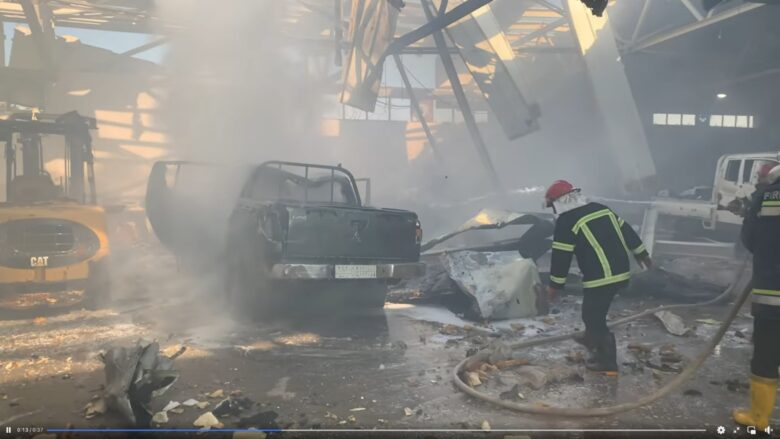 Destruction at the Simav Printing Press after the Turkish airstrike on 25 December 2023. Source: (Rojava FM).
Destruction at the Simav Printing Press after the Turkish airstrike on 25 December 2023. Source: (Rojava FM).
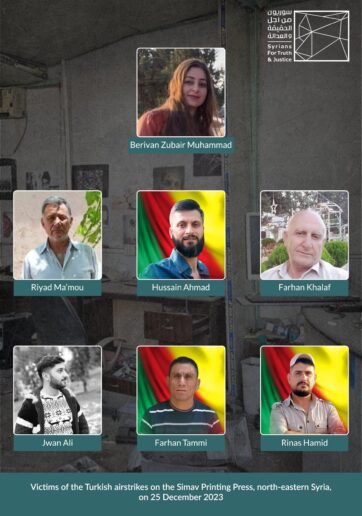
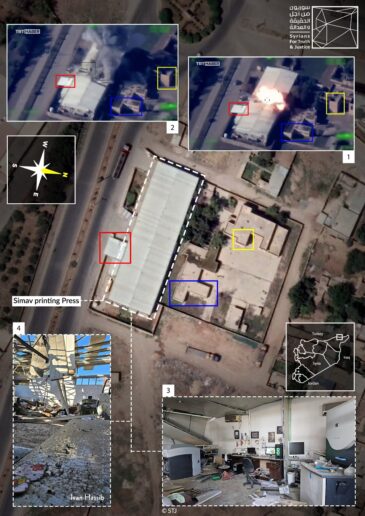
Designed by STJ, this image matches screenshots 1 and 2 from the TRT HABER video, capturing the 25 December Turkish airstrike on the Simav Printing Press, with satellite footage of the facility (geolocation: 37.070302, 41.246160). The image includes photos 3, by STJ, and 4, by journalist Ivan Hassib, which document destruction at different parts of the facility.
Attack on the Umm al-Fursan Mill
On the same day, at around 03:30 p.m., Turkish warplanes hit a cotton ginning facility, known by its old name as the Umm al-Fursan mill, located northeast of Qamishli/Qamishlo city. The attack killed one female worker and injured three others.
The victim, Aya al-Muhammad (18), was anticipating a wedding and had picked a job at the cotton facility only a short time ago “to help her father and brother with the family’s financial burdens”. Aya died on her way to the hospital from a cut on her neck. One of her coworkers sustained light injuries, while the second underwent two surgeries for her serious wounds, according to Zahra al-Yassin,[3] the fourth worker and a survivor of the attack.
Zahra herself had surgery to extract shrapnel after four fragments rested in her right leg, one of which “penetrated the flesh on one side and exited through the other”. Zahra, still unable to overcome the trauma of that day, described the moment the warplane targeted their facility:
“There were five of us [. . .]. We could hear the sound of the shelling, but it was distant. We did not expect the warehouse to be filled with dust and smoke in a blink. Glass fragments were flying around and falling on us.”
For additional information on the attack, STJ also spoke to the warehouse keeper, Jawad al-Ali,[4] who was sitting in his office only 15 meters away from the site when the aircraft hit. He narrated:
“The mortar or missile targeted the warehouse and punctured the zinc rooftop [. . .]. Seven zinc panels and the metal joists were destroyed. At the time, there were nearly 400 tons of barley in the warehouse; 120 bags had approximately burned down, amounting to over ten tons. Approximately 200 kilograms of cotton also caught fire. The losses would have been greater if the workers and people did not extinguish the fires on time.”
The witness stressed that there are no security or military headquarters near the cotton facility; the closest such headquarters—the Umm al-Fursan prison—is 500 meters away. He said:
“The airstrike was most likely deliberate, as they [the Turkish military] bombarded all the hangars that had zinc panel roofing, such as the printing press and the sewing facility, among others.
For his part, one of the cotton facility owners, Khalid al-Hussain,[5] told STJ that he was shocked upon hearing the facility was targeted because it was civilian and had a long history of offering services to the local community. Before it was transformed into a cotton ginning facility, the building was first opened as a wheat mill in 2014 to provide the region’s residents with bread flour. Hussain estimated the financial losses at thousands of dollars, emphasizing that:
“The barley stored in the warehouse reduced the scale of the disaster because the barely bags absorbed the pressure from the exploding projectile and prevented its fragments from spreading across the place.”
Designed by STJ, the image below matches an exclusive photo obtained by STJ of the cotton-ginning warehouse, hit on 25 December 2023 by Turkish warplanes, and satellite footage of the facility (geolocation: 37.052484, 41.307316). The image also includes photos 2, by Rojava FM, and 3, by Buyer media outlet, which capture damage at the facility.
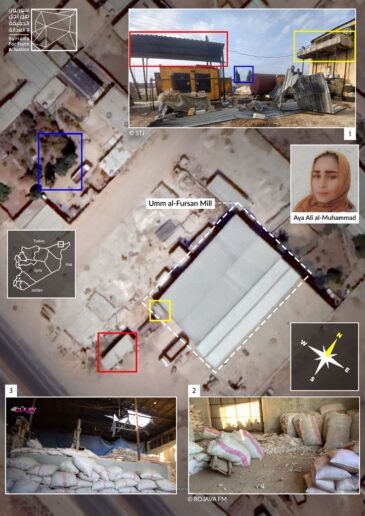
Attack on the Straw Plant
At around 10:30 a.m. on the same day, Turkish aircraft targeted a facility specialized in manufacturing straw used in desert air conditioners. The airstrike deprived approximately 20 families and numerous day laborers of their only source of income due to the massive material damage that rendered the facility inoperable. The plant owner, Hazem al-Sayyed,[6] said:
“The strike set aflame two of the three machines that operated the plant and the power generator. Additionally, the entire warehouse was destroyed and its contents burned down [. . .]. I lost about 50 to 60 thousand USD, considering the burned timber and machines and the destroyed warehouse.”
Hazim is convinced the destruction at his facility was not merely collateral damage because the other targeted facilities are over 500 meters from his plant. He stressed that:
“[The plant] is a civilian facility. We have ties with neither the military nor security entities. All the workers are civilians. Also, the pieces of land and the houses surrounding the facility belong to us and other civilian families in the neighbourhood. In the remaining part of the neighbourhood, there are the rail station, a few civilian warehouses, and civic institutions of the autonomous administration.”
Designed by STJ, the image below matches photo 2, by North Press, of the straw plant hit on 25 December 2023 by Turkish warplanes and satellite footage of the facility (geolocation: 37.051079, 41.253608). The image also includes photos 1, by journalist Ivan Hassib, and 3, by STJ, which capture damage at the facility.
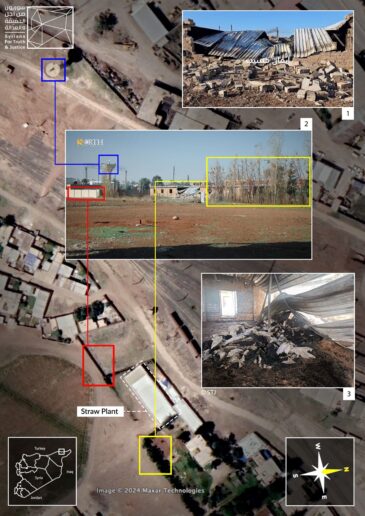
Annex
STJ’s digital forensics team analyzed the drone footage by Turkish TRT HABER, which documents the airstrikes on 11 facilities in northeast Syria on 25 December 2023. The team geolocated all 11 targeted facilities and identified eight, which are listed below in the order they appear in the video:
- Al Jazeera Feed Factory (geolocation: 065860, 41.247121).
- Simav Printing Press (geolocation: 070302, 41.246160).
- Sewing Facility (geolocation: 057790, 41.258771).
- Unidentified (geolocation: 068596, 41.243973).
- The Medical Oxygen Plant at the Kidney Dialysis Center (geolocation: 053993, 41.262560).
- Unidentified (geolocation: 065355, 41.248073).
- Mashta al-Nour Medical Centre in Ayn al-Arab/Kobanî (geolocation: 890843, 38.342968).
- Unidentified (geolocation: 073375, 41.236230).
- Construction vehicle (geolocation: 068864, 41.249357).
- Former detergents factory, near the Buttan Fuel Station (geolocation: 061309, 41.244495).
- Construction vehicle (geolocation: 068645, 41.248575).
STJ will publish another report investigating the Turkish airstrikes on several of the facilities identified above, and an extensive report unveiling the patterns of the Turkish trikes in northeast Syria over October and December 2023, as well as January 2024.
[1] He was interviewed in person on 21 January 2024.
[2] The witness opted for using a pseudonym during an in-person interview on 21 January 2024.
[3] The witness opted for using a pseudonym during an in-person interview on 10 January 2024.
[4] The witness opted for using a pseudonym during an in-person interview on 9 January 2024.
[5] The source opted for using a pseudonym during an in-person interview on 10 January 2024.
[6] The source opted for using a pseudonym during an in-person interview on 9 January 2024.

